At some point the previous day, we entered the Reserva Nacional de Fauna Andina de Eduardo Avaroa, named after one of the Bolivian “heroes” of the War of the Pacific in the 19th century (which Bolivia lost, along with its pacific coast). This national park includes lagunas full of borax, arsenic and cyanobacteria which, apart from being catnip to the local flamingos, create a waterscape of blues, greens, whites and reds.
Rising from 4,200m to 4,900m, with sunny days and freezing nights, this is a harsh environment and a dense coat of fur or feathers, and a strong stomach, is highly recommended if you want to make this your home. Fortunately we’re well acclimatised, and our jackets and sleeping bags have more down than Grandma’s feather bed. Our stomachs are getting more resilient too, after a diet of porridge, couscous and noodles for the past three weeks. We’ve resisted the temptation to drink from the lagoons, preferring instead the life-affirming properties of the Coca Cola Corporation and flasks of hot water they hand out at most of the hostelries in this part of the world.
Having handed over 150 Bolivianos at the park gate, in honour of our brave (if unsuccessful) comrade Eduardo, we find ourselves in the unusual position of being well-fed, relatively warm, in a place of great beauty, with a relatively short day ahead of us. Uncertain as to the protocol for dealing with this turn of events, we sit down, relax and enjoy a quiet couple of hours soaking up the magnificence of Laguna Colorada, taking photos and terrorising the gulls with my drone. It’s a very special time after the trauma of the last five days, and it’s with some reluctance that we haul ourselves back onto our bikes for the 600m climb to the Sol de Manana, a geothermal area 25km away.
Sol de Manana means “Sun in the Morning” as the steam vents, mud pools and geysers are at their steamiest, muddiest and geyseriest shortly after the sunrise. We’re planning on camping in the least squishy place we can find, staving off the cold in this, our highest campsite so far, with a stiff upper lip and plenty of cups of coffee. But we have to get there first and, as usual, the forces of evil hamper our progress with devilish crosswinds and road surfaces. It’s approaching 6pm when we finally sail into port, weighing anchor and securing our temporary home, as best we can, with rocks recently belched from magma pools deep below the surface.
For some reason, we’ve chosen to pitch our tent 400m from the noisiest steam vent this side of the moons of Jupiter. We dream of babbling brooks, tinkling waterfalls and jet-engine rigs, before waking to a dawn chorus of 4×4 engines and camera shutters. It’s only 6am and tourists are already here. Good grief! We chisel the ice off our sleeping bags, fire up the drone engines and wipe the porridge from our mouths before spilling out of the tent to join the throng.
Once the first wave of tourists subsides, we strike camp, adopt a morally superior manner and begin the long freewheel down to Lake Chalviri, looking forward to warmth and oxygen 500m below us. We’re not disappointed, even if the thermal baths on the lake shoreline are a few degrees too cold to tempt us in, and seem an unnecessary luxury as we’ve both washed in the previous fortnight. We spend the night in the second best hotel in town.
From Chalviri it’s another climb, this time through the Desierto Salvador Dali which, according to the brochure, is a surrealist landscape of rocks and, er, desert. At the top of the climb, having been pounded by the wind most of the way, we picture a road-sign saying “Pain, suffering and disappointment ahead”. The reward for our efforts (apparently) being even stronger headwinds than before and bottomless sand as far as the eye can see. We deploy our emergency bucket and spade, before finding a rock to shelter behind for a feast of eggs, tuna, mayonnaise and crackers. When it comes to feasts, it’s a low bar.
By mid-afternoon, the wind has turned again and all is forgiven, as Laguna Blanca and Laguna Verde come into view. The place is deserted but, even if a Costa Coffee would be welcome, we don’t mind the solitude as the wild camping allows us to enjoy these moments in complete tranquillity. Or it would if the wind wasn’t howling so loudly. Dronio’s doing his best to capture the moments before sunset, when the lake’s at its most green. There are mountains all round us and Laguna Blanca stretches off into the distance towards the border with Chile, our destination for the next day.
At first light Laguna Verde is decidedly blue, and the early arrivals are scratching their heads and checking their cameras settings. This is probably not the best time of day for photos. They’ll need to come back later on if they want to see Laguna Blanca and Laguna Verde living up to their billing, in a way only lakes full of toxic chemicals can.
The conditions are often nice in the morning, and we enjoy a pleasant 10km cycle along the shore of Laguna Blanca, past Bolivian customs and up the rise that eventually leads to the border post. Predictably the wind picks up in an attempt to prolong our stay in Bolivia for a little while longer. But we can smell Chilean wine in the air and push on. An hour later, we have our exit stamps and are looking forward to the long descent to San Pedro. Unfortunately, owing to a map-reading error, we discover we have to climb for another 4km before reaching the main road. Additionally, due to a tarmac-laying error, the beautifully smooth asphalt roads have not made it as far as the Bolivian border, and we have to postpone the tarmac-kissing photo I’d intended to take when the opportunity arose.
After a short interval we spot the Chilean border post, in a building modelled after the place in Arizona where the aliens are kept. The garage doors are opened by unseen hands and we’re ushered in. The border guards relieve us of half an onion and a pot of honey before we emerge, blinking, on the other side. Tarmac duly kissed, we turn right, release the brakes and start an epic descent to San Pedro, 42km along and 2,200m below.
San Pedro is where Andy and I depart company, Andy heading north to Peru and I heading southeast into Argentina. It’s the end of phase one for sure, although a great adventure in itself. 720 miles, mostly on dirt roads, mostly wind affected, mostly cold, but mostly through some of the most awesome and other-worldly scenery this planet has to offer. Not for the faint-hearted, and definitely not many people’s idea of fun, but something memories are made of with the good bits enduring while the less good bits fade.
As the border post in San Pedro was closed a few years ago, options for getting to Argentina have been greatly reduced. My plan to head south over the Paso Socompa will have to be shelved. I’ll be taking the bus to Salta instead and finding my way back to the mountains from there. As things are up in the air a bit, it may be while before my next post so, until then, Buen Viaje!
-
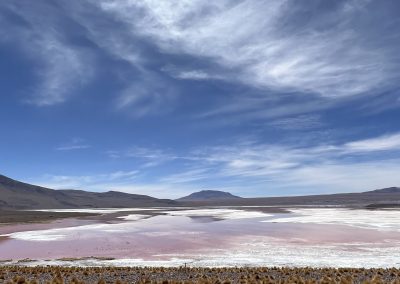
Laguna Colorada
-

Vicuna
-

Yes, it really is this colour
-
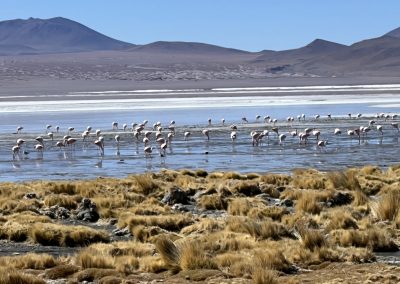
Happy flamingos
-

Sol de Manana first thing in the manana
-

The steam subsides as the sun rises
-

Puffing Billy
-

Gloop!
-

…
-

Hot mud may be good for the complexion, but…
-

No warning signs or fencing to be seen
-

The long descent to Laguna Chalviri
-

Handcare courtesy of the altiplano
-

Laguna Chalviri
-

Accommodation can be basic
-

Something to keep the dust off the grub!
-
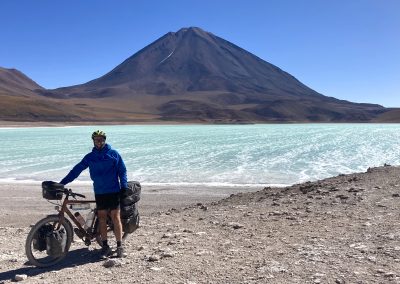
Laguna Mucha Verde
-
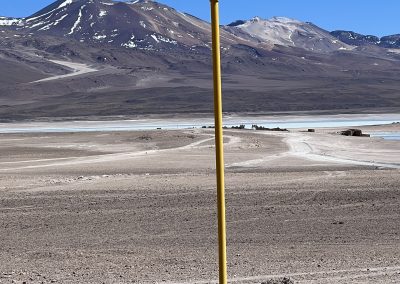
The start of the climb to Chile
-
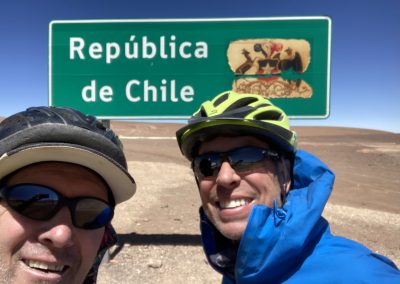
Nearly there
-

Mwah!

